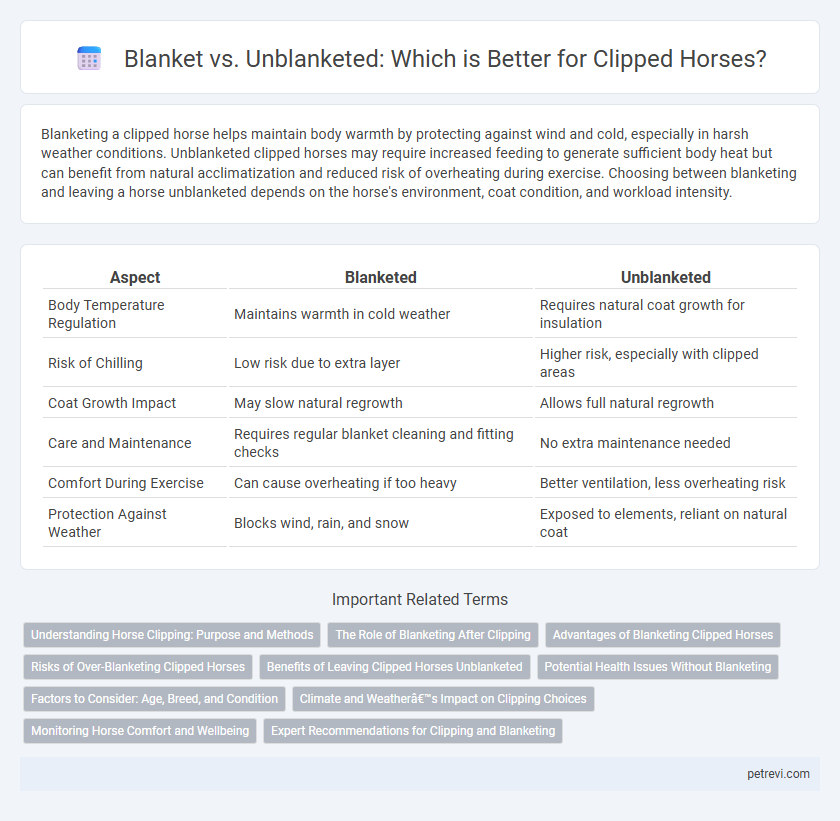Blanketing a clipped horse helps maintain body warmth by protecting against wind and cold, especially in harsh weather conditions. Unblanketed clipped horses may require increased feeding to generate sufficient body heat but can benefit from natural acclimatization and reduced risk of overheating during exercise. Choosing between blanketing and leaving a horse unblanketed depends on the horse's environment, coat condition, and workload intensity.
Table of Comparison
| Aspect | Blanketed | Unblanketed |
|---|---|---|
| Body Temperature Regulation | Maintains warmth in cold weather | Requires natural coat growth for insulation |
| Risk of Chilling | Low risk due to extra layer | Higher risk, especially with clipped areas |
| Coat Growth Impact | May slow natural regrowth | Allows full natural regrowth |
| Care and Maintenance | Requires regular blanket cleaning and fitting checks | No extra maintenance needed |
| Comfort During Exercise | Can cause overheating if too heavy | Better ventilation, less overheating risk |
| Protection Against Weather | Blocks wind, rain, and snow | Exposed to elements, reliant on natural coat |
Understanding Horse Clipping: Purpose and Methods
Horse clipping is a grooming practice that involves trimming or shaving the horse's coat to regulate body temperature and enhance comfort during work or competition. Choosing whether to blanket a clipped horse depends on factors such as climate, workload, and the horse's natural coat growth, with blankets providing insulation and protection from cold weather. Proper clipping methods, like full or trace clipping, impact the horse's thermoregulation and dictate the necessary blanket use to maintain optimal health and performance.
The Role of Blanketing After Clipping
Blanketing plays a crucial role in maintaining a horse's body temperature after clipping by providing insulation and protection from cold weather, reducing the risk of chills and illness. Horses clipped for easier grooming and temperature regulation benefit from blankets that mimic their natural winter coat, helping to retain warmth and prevent discomfort. Choosing the right weight and fit of a blanket ensures optimal thermal regulation and supports the horse's overall health and performance during colder months.
Advantages of Blanketing Clipped Horses
Blanketing clipped horses provides essential warmth and protection against cold weather, reducing the risk of chills and respiratory issues. It helps maintain consistent body temperature, supporting muscle function and overall health during colder months. Using a breathable, waterproof blanket also shields horses from wind and rain, preventing discomfort and potential skin problems.
Risks of Over-Blanketing Clipped Horses
Over-blanketing clipped horses can lead to excessive sweating, which increases the risk of skin infections and chills due to trapped moisture. Horses with clipped coats require careful temperature regulation to avoid overheating or becoming too cold, making blanket choice and monitoring essential. Overuse of heavy blankets may also cause discomfort and stress, negatively impacting their overall health and performance.
Benefits of Leaving Clipped Horses Unblanketed
Leaving clipped horses unblanketed allows their natural coat to regulate body temperature, preventing overheating and promoting improved sweating during exercise. This approach supports the horse's natural thermoregulation, reducing the risk of skin irritation and fungal infections often associated with trapped moisture under blankets. Horses kept unblanketed also experience increased air circulation, enhancing coat drying and overall skin health after clipping.
Potential Health Issues Without Blanketing
Without blanketing, clipped horses risk hypothermia due to decreased natural insulation, especially in cold or wet weather conditions. Exposure to dampness can lead to respiratory issues and skin irritations such as rain rot or fungal infections. Maintaining proper warmth with appropriate blankets is essential to prevent these health complications and support overall equine well-being during colder seasons.
Factors to Consider: Age, Breed, and Condition
When deciding between blanketing and leaving a horse unblanketed after clipping, consider the horse's age, breed, and overall condition to ensure optimal comfort and health. Younger horses and those with thin coats or lighter breeds may require blankets to maintain body warmth, especially in colder climates. Horses with thick coats or older, hardy breeds might tolerate clipping without a blanket, provided they are in good condition and sheltered from extreme weather.
Climate and Weather’s Impact on Clipping Choices
Choosing to blanket or not after horse clipping significantly depends on the climate and weather conditions. In colder, wetter environments, blanketing is essential to prevent hypothermia and maintain the horse's body temperature, while in milder or dryer climates, horses may remain comfortable unblanketed, especially if they have adapted to the weather. Monitoring daily weather patterns, including temperature fluctuations and wind chill, guides owners in making informed decisions to protect clipped horses from stress and illness.
Monitoring Horse Comfort and Wellbeing
Regularly monitoring a clipped horse's comfort and wellbeing involves assessing body temperature, coat regrowth, and stress indicators when choosing between blanket or unblanketed care. Horses without blankets may experience chills or sluggish recovery, especially in cold climates, while over-blanketing can cause overheating and skin irritation. Implementing a tailored blanket regimen based on weather conditions, horse health status, and clip type ensures optimal equine comfort and prevents health complications.
Expert Recommendations for Clipping and Blanketing
Expert recommendations for horse clipping emphasize the importance of assessing the horse's environment, coat type, and workload before deciding to blanket. Clipping reduces the natural insulation of a horse's coat, necessitating the use of appropriately weighted blankets to maintain thermal comfort, especially in colder climates or during intensive training. Veterinarians and equine specialists advise scheduling clipping sessions during transitional seasons and pairing them with breathable, moisture-wicking blankets to prevent chills and skin irritations.
Blanket vs Unblanketed for Horse Clipping Infographic

 petrevi.com
petrevi.com